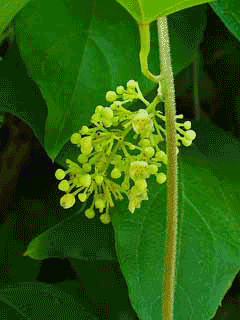 |
|
http://commons.wikimedia.org/wiki/File:Cocculus_orbiculatus_002.JPG |
 |
| http://commons.wikimedia.org/wiki/File:Cocculus_orbiculatus_003.JPG |
Translate this page:
Summary
Physical Characteristics

 Cocculus orbiculatus is a deciduous Climber growing to 4 m (13ft 1in).
Cocculus orbiculatus is a deciduous Climber growing to 4 m (13ft 1in).
See above for USDA hardiness. It is hardy to UK zone 7. It is in flower in August, and the seeds ripen in October. The species is monoecious (individual flowers are either male or female, but both sexes can be found on the same plant).
Suitable for: light (sandy), medium (loamy) and heavy (clay) soils and prefers well-drained soil. Suitable pH: mildly acid, neutral and basic (mildly alkaline) soils. It can grow in semi-shade (light woodland) or no shade. It prefers moist soil.
UK Hardiness Map
US Hardiness Map
Synonyms
C. thunbergii. C. trilobus. Cebatha orbiculata. Menispermum trilobum.
Plant Habitats
Woodland Garden Dappled Shade; Shady Edge;
Edible Uses
Edible Parts: Leaves Root
Edible Uses:
Leaves - cooked. An emergency food, it is used when all else fails[177]. One report says that the root might be edible[177].
References More on Edible Uses
Medicinal Uses
Plants For A Future can not take any responsibility for any adverse effects from the use of plants. Always seek advice from a professional before using a plant medicinally.
Anodyne Antiasthmatic Antiphlogistic Antirheumatic Carminative Depurative Diuretic Vermifuge
The root is anodyne, antiphlogistic, antirheumatic, carminative, depurative, diuretic and vermifuge[147, 176, 218]. It is used in the treatment of rheumatic arthritis, oedema and oliguria[176]. It has also shown antibacterial and anti-amoebic activity[176]. A decoction of the stems is used in the treatment of asthma, bronchitis and paralysis[218].
References More on Medicinal Uses
The Bookshop: Edible Plant Books
Our Latest books on Perennial Plants For Food Forests and Permaculture Gardens in paperback or digital formats.

Edible Tropical Plants
Food Forest Plants for Hotter Conditions: 250+ Plants For Tropical Food Forests & Permaculture Gardens.
More

Edible Temperate Plants
Plants for Your Food Forest: 500 Plants for Temperate Food Forests & Permaculture Gardens.
More

More Books
PFAF have eight books available in paperback and digital formats. Browse the shop for more information.
Shop Now
Other Uses
Basketry Insecticide
The bleached tendrils are used as an ornamental infill in basket making[46, 61]. The plant contains cocculoidine which has insecticidal activity[218].
Special Uses
References More on Other Uses
Cultivation details
Easily cultivated in an ordinary garden soil[1], it prefers a well-drained moisture retentive fertile soil in full sun or semi-shade[200]. Plants only fruit well when grown in full sun[219]. This species is hardy to about -10°c[200]. Plants climb by means of twining around supports[219]. They do not normally require pruning[219]. Closely related to C. carolinus[200].
References Carbon Farming Information and Carbon Sequestration Information
Temperature Converter
Type a value in the Celsius field to convert the value to Fahrenheit:
Fahrenheit:
The PFAF Bookshop
Plants For A Future have a number of books available in paperback and digital form. Book titles include Edible Plants, Edible Perennials, Edible Trees,Edible Shrubs, Woodland Gardening, and Temperate Food Forest Plants. Our new book is Food Forest Plants For Hotter Conditions (Tropical and Sub-Tropical).
Shop Now
Plant Propagation
Seed - we have no details for this species but suggest sowing the seed as soon as it is ripe in a greenhouse. Sow stored seed as soon as possible in a greenhouse. When they are large enough to handle, prick the seedlings out into individual pots and grow them on in the greenhouse for at least their first winter. Plant them out in late spring or early summer, after the last expected frosts. Root cuttings in December in a greenhouse[200]. Division in the dormant season. Cuttings of half-ripe wood, July/August in a frame[200].
Other Names
If available other names are mentioned here
Native Range
TEMPERATE ASIA: Korea, Japan (Hokkaidô, Honshu, Kyushu, Ryukyu Islands, Shikoku), Taiwan
Weed Potential
Right plant wrong place. We are currently updating this section.
Please note that a plant may be invasive in one area but may not in your area so it's worth checking.
Conservation Status
IUCN Red List of Threatened Plants Status :

Growth: S = slow M = medium F = fast. Soil: L = light (sandy) M = medium H = heavy (clay). pH: A = acid N = neutral B = basic (alkaline). Shade: F = full shade S = semi-shade N = no shade. Moisture: D = dry M = Moist We = wet Wa = water.
Now available:
Food Forest Plants for Mediterranean Conditions
350+ Perennial Plants For Mediterranean and Drier Food Forests and Permaculture Gardens.
[Paperback and eBook]
This is the third in Plants For A Future's series of plant guides for food forests tailored to
specific climate zones. Following volumes on temperate and tropical ecosystems, this book focuses
on species suited to Mediterranean conditions—regions with hot, dry summers and cool, wet winters,
often facing the added challenge of climate change.
Read More
Expert comment
Author
(L.)DC.
Botanical References
109200
Links / References
For a list of references used on this page please go here
Readers comment
| Add a comment |
|
If you have important information about this plant that may help other users please add a comment or link below. Only comments or links that are felt to be directly relevant to a plant will be included. If you think a comment/link or information contained on this page is inaccurate or misleading we would welcome your feedback at [email protected]. If you have questions about a plant please use the Forum on this website as we do not have the resources to answer questions ourselves.
* Please note: the comments by website users are not necessarily those held by PFAF and may give misleading or inaccurate information.
To leave a comment please Register or login here All comments need to be approved so will not appear immediately.
|
Subject : Cocculus orbiculatus
|
|
|
|